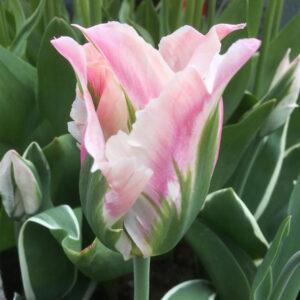Tips for tulips – especially when growing in pots
Planting and growing tulips in pots is a great way to enjoy these beautiful flowers if you have limited garden space and rely on container gardening: they will brighten up your balcony and bring a fresh spring feel to any patio or roof terrace after the cold and dark winter months have ended (roll on March!).
To get the best blooms, you’ll need to make sure you’re giving the bulbs everything they need as you plant and care for them throughout the winter. The size of your container, the type and quality of compost you plant in, and how you plant the bulbs themselves will all impact how well your tulips will grow and bloom.
Here are 7 detailed tips to planting tulips in pots this autumn that we’ve developed with the help of Helen Bond from @seasonalgardens:
- Select high quality tulip bulbs
There are so many varieties, it is hard to know what to grow. With careful selection of varieties, it is possible to enjoy a display of tulips all the way through from the end of March to the end of May.
Look for bulbs that are firm, plump, and free from signs of disease or rot. Larger bulbs typically produce bigger and more robust flowers.
Whilst garden centre bulbs are often of good quality and price, they tend to stock a limited selection of around 20 of the popular varieties, compared with a specialist supplier (like peternyssen.com or the more expensive Bloms) who offer the choice of over 300 bulb varieties. If you are an NG subscriber, we have a discount code with peternyssen.com to give you 10% off orders placed in November. The code will be sent out on Saturday 4th November, so if you havent already – subscribe now!!
Need inspiration? Helen loves the beautiful double (peony-flowering) Finola. The China Town pretty pink and white bloom, featured below, generally grows to 30cm height as a mature plant, so it’s a good one to choose for growing in a pot. The variegated leaf provides for an attractive looking plant, even before China Town flowers, giving an extended period of interest for your growing space.

Ollioules (shown below) – like Clearwater (straight and sturdy in the wind) – grow to a height of 55cm when mature.

Helen recommends that if you’re planting in multiple pots, ensure you stand the pots containing the taller varieties behind the shorter growing height tulips.
- Select the right pot and place
Your container should be at least 30cm deep with drainage holes at the bottom to prevent waterlogging. It’s really that simple. As for where you stand your pots, apparently there’s a little more to consider.
Choose a colour and height of tulip that will work best with their surroundings or backdrop. Growing in front of brickwork? Then plant a deep orange like Ballerina of the beautifully fragrant Princess Irene.
Do you have an ugly fence to hide? With container gardening you can move your pots around to make the most of their height, and choose a tall tulip like Clearwater. You can grow them in shadier spots until they break through the soil, but then they need to be placed in the sun. Purissima works (ivory cream colour) in semi-shadier spots and it brightens darker corners.
- Use well-draining soil
Bulbs will rot if too wet. Fill the pot with a well-draining potting mix. You can mix regular potting compost with some perlite or coarse sand to improve drainage. Our peat free compost is perfect to use with some perlite or coarse sand mixed in.
- Planting
- Place your peat-free compost mixture in a layer at the bottom of your pot.
- Normally, in the garden, one would space the tulip bulbs about 7-10cm apart. But in a pot, you can get away with planting them a minimum distance of just a few centimetres apart. Make sure they aren’t touching as they will rot. As for depth, Helen usually plants them deep in the garden, but in a pot she reckons that 15cm inches deep is fine. The pointed end of the bulb should face upward.
- Cover the bulbs with compost, leaving about 1 inch of space between the compost surface and the rim of the pot to allow for watering.
- Keep the pots outdoors in a sheltered area where they will experience the cold temperatures through the winter. Once the leaves start pushing through the compost, you can move the pot to wherever you like and enjoy watching the tulips embrace the spring!
- Watering
After planting, water the pots thoroughly to settle the compost and ensure good contact with the bulbs.
Water sparingly during the winter to prevent rot but keep the compost slightly moist. I recommend top-dressing with our plant feed and soil conditioner at the time of planting, and again in Jan or Feb, as this locks in moisture, and will also provide a slow release feed in the spring.
Once you see leaves appearing, test your compost for moisture. Give consideration to the amount of rainfall over winter; it may be that you don’t need to water that much at all. Too much water is much worse for them than not enough.
- Feeding
You won’t need to start feeding your plants in pots until you can see shoots appearing. If you added a mulch to the surface of the pots with our plant feed and soil conditioner, that will now be giving the tulip bulbs a slow-release feed.
Be careful not to use a high nitrogen feed, or you will end up with lots of leaves and no flowers. Our natural liquid feed has a nicely balanced NPK ratio (Nitrogen-Phosphorous-Potassium) that will give the tulips all the nutrients and trace elements they need to be healthy and produce vibrant flowers.
Remember that pots regularly need more nutrients added as they can drain out, so a regular liquid feed will ensure a continued supply of nutrients.
Managing squirrels
Helen’s last tip was in relation to squirrels as they find tulip bulbs incredibly tasty!
If your pots or tulips beds are likely to be targeted by resident squirrels, it’s important to protect them as soon as you plant them in. This avoids them being dug up. Chicken wire is good for this and can be removed as the leaves start pushing through.
Squirrels are not so keen on narcissi bulbs, so if you are using a large pot you could also layer the pot, planting May flowering tulip varieties deeper but also adding some early narcissi slightly closer to the surface to try to put the squirrels off the scent! The narcissi would flower in March and, as they die back, the tulips would take over the display.
If you are container gardening on a balcony or in a squirrel-free garden, then crocus are also excellent bulbs to layer with as they flower in February/early March.
I hope that some of these tips and recommendations are useful!
Happy growing!









